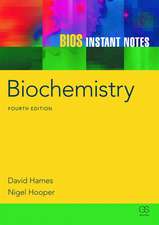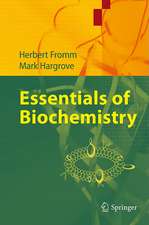Redesigning the Molecules of Life: Conference Papers of the International Symposium on Bioorganic Chemistry Interlaken, May 4–6, 1988
Association of Swiss Chemists Editat de Steven A. Benneren Limba Engleză Paperback – 19 apr 1988
Preț: 636.30 lei
Preț vechi: 748.59 lei
-15% Nou
Puncte Express: 954
Preț estimativ în valută:
121.77€ • 126.41$ • 101.54£
121.77€ • 126.41$ • 101.54£
Carte tipărită la comandă
Livrare economică 24 martie-07 aprilie
Preluare comenzi: 021 569.72.76
Specificații
ISBN-13: 9783540191667
ISBN-10: 3540191666
Pagini: 184
Ilustrații: VII, 175 p.
Dimensiuni: 170 x 244 x 10 mm
Greutate: 0.3 kg
Editura: Springer Berlin, Heidelberg
Colecția Springer
Locul publicării:Berlin, Heidelberg, Germany
ISBN-10: 3540191666
Pagini: 184
Ilustrații: VII, 175 p.
Dimensiuni: 170 x 244 x 10 mm
Greutate: 0.3 kg
Editura: Springer Berlin, Heidelberg
Colecția Springer
Locul publicării:Berlin, Heidelberg, Germany
Public țintă
ResearchDescriere
The organic chemist is rarely satisfied by a simple "explanation" of the reactivity of organic molecules. Rather, the chemist wants to go one step further, to "control" the behavior of molecules by altering their structure in a controlled way. This is, in fact, a rather stringent definition of "understanding," as it requires the "prediction" of behavior from structure (or structure from behavior). But it also places technical demands on the chemist. He must be able to synthesize the molecules he studies, characterize them at the atomic level of structural resolution, and then measure their behaviors to the precision that his explanation demands. Biological chemistry presents special problems in this regard. Although the tools for synthesis, purification, and structural characterization are now available for manipulating rather large biological macromolecules (proteins and nucleic acids in particular), the theory supporting these manipulations is inadequate. We certainly do not know enough to control generally the behavior of biological macromolecules; still worse, it is not clear that we know enough to design synthetic molecules to expand our understanding about how reactivity in such biological macromolecules might be controlled. Starting from scratch, there are simply too many oligopeptides to make; starting from native proteins, there are simply too many structural mutations that might be introduced.
Cuprins
Nicotinamide as a Coenzyme. An Evolutionary Model of Catalysis and Some Attempts to Translate Ideas into Testable Chemistry.- The Design of Peptides and Proteins Ranging from Hormones to Enzymes.- Altering the Structure of Enzymes by Site-Directed Mutagenesis.- Structure and Activity of Ribozymes.- Reconstructing the Evolution of Proteins.









